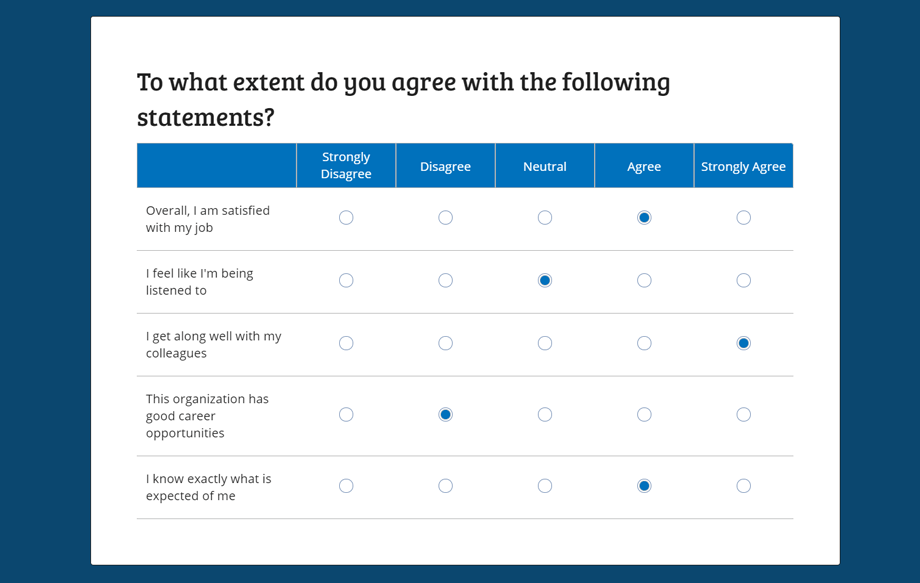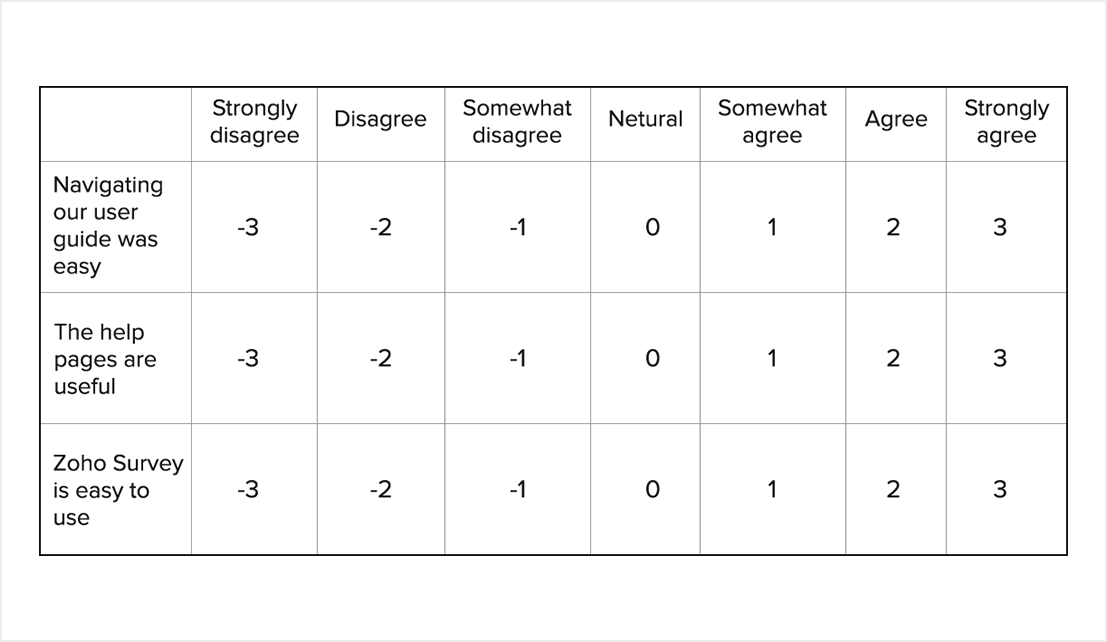Welcome to our expert guide on the purpose and benefits of using a Likert scale in surveys! As seasoned professionals in this field, we are here to provide you with an in-depth understanding of this invaluable tool. A Likert scale is a widely used method for measuring attitudes and opinions through carefully crafted statements or questions. Whether you are an experienced researcher looking for new ways to gather data or a student conducting your first survey project, incorporating it into your methodology will undoubtedly enhance your research experience and provide meaningful results.
What Is a Likert Scale?
- The Likert scale is a powerful psychometric measurement tool that allows researchers to gauge attitudes, opinions, and perceptions toward a specific subject.
- Respondents are presented with multiple statements or items that they rate on a numerical scale, reflecting their level of agreement or disagreement.
- The scale typically ranges from 1 (Strongly Disagree) to 5 (Strongly Agree), capturing nuanced responses effectively.
Unveiling Its Origins
- The Likert scale was developed by psychologist Rensis Likert in 1932 as part of his groundbreaking research on measuring subjective experiences.
- Originally designed for assessing employee attitudes within organizations, it has since become widely adopted across diverse fields such as psychology, sociology, marketing research, education, and more.
Harnessing the Power of the Likert Scale
- Surveys: Researchers rely heavily on Likert scales when collecting data about people’s opinions on specific topics.
- Research Studies: In academic studies, experts leverage the versatility of the Likert scale to measure variables related to attitudes, beliefs, behaviors, preferences, and other psychological constructs.
The Mechanics of a Likert Scale
A Likert scale is an indispensable psychometric measurement tool that allows you to measure attitudes, opinions, or perceptions effectively. By presenting respondents with multiple statements or items to rate on a numerical scale, you gain invaluable quantitative data for analysis.
Likert scales come in various formats, such as 3-point, 5-point, 7-point, and even 10-point scales. The choice depends on your research objectives and desired level of granularity.

Crafting Effective Likert Scale Questions
Designing well-formulated questions is crucial for obtaining accurate results from your survey participants. Here are some essential tips for creating impactful Likert scale questions:
- Clearly define the construct you want to measure (e.g., satisfaction with customer service).
- Craft statements that reflect different levels or aspects related to the construct (e.g., “The customer service representative was knowledgeable”).
- Ensure each statement represents only one idea or concept to avoid confusion among respondents.
Best Practices for Formulating Powerful Questions
- Use clear language: It is vital that your statements are concise, easily understandable, and devoid of any ambiguity. This ensures that respondents can provide accurate and meaningful responses.
- Avoid leading questions: Phrase your statements neutrally to prevent biasing responses in any particular direction. This allows for a more objective assessment of attitudes or opinions.
- Balance positive and negative statements: Including both positively worded and negatively worded items captures diverse perspectives accurately. This approach provides a comprehensive understanding of the subject matter being assessed.
The Advantages of Using a Likert Scale
We singled out the top 5 benefits of using this amazing method—check them out below.
Precision Perfected
Say goodbye to simplistic yes/no questions or binary options! The beauty of a Likert scale lies in its ability to capture nuanced responses. By offering respondents multiple response options, you unlock a treasure trove of attitudes and opinions on any given topic. This heightened level of granularity empowers researchers with profound insights into participants’ thoughts and emotions.
Format Freedom
Flexibility reigns supreme when it comes to Likert scales, allowing respondents to express their agreement or disagreement along a continuum. While the classic “Strongly Agree” to “Strongly Disagree” range is widely used, variations like “Very Satisfied” to “Very Dissatisfied” are equally effective. This adaptability makes Likert scales suitable for diverse research contexts by accommodating different types of statements or questions.
Analysis Made Easy
Analyzing data collected through a Likert scale is refreshingly straightforward, thanks to its structured nature. Responses can be effortlessly quantified by assigning numerical values (e.g., 1-5) corresponding to each option on the scale. These numerical values pave the way for statistical analysis techniques such as mean calculation, standard deviation estimation, and correlation analysis.
Validity and Reliability Reinforced
A meticulously designed Likert scale bolsters both the validity and reliability of your research findings. By crafting statements that comprehensively cover all relevant aspects related to your research question, you ensure content validity – accurately measuring what you intend to measure. Furthermore, utilizing established scales with proven psychometric properties enhances the reliability of your results, as they have undergone rigorous testing and validation.
Real-World Triumphs
Likert scales have left an indelible mark across a multitude of disciplines, revolutionizing data collection in countless studies. In the realm of marketing research, Likert scales reign supreme when it comes to measuring customer satisfaction or brand perception. Within educational settings, these scales serve as invaluable tools for assessing students’ attitudes toward specific subjects or teaching methods. These real-world triumphs exemplify the unrivaled effectiveness and versatility of Likert scales in capturing profound insights.

Making the Most of Your Likert Scale Data
Master the art of analyzing and interpreting scale data like a true professional—follow our tips below.
Analyzing Likert Scale Data
Begin by calculating descriptive statistics such as mean, median, and mode for each item on your Likert scale. These measures offer a comprehensive overview of respondents’ opinions or attitudes towards specific statements. Look for intriguing patterns in the data by examining frequency distributions and creating visually appealing bar charts or histograms. These visual representations can unveil hidden trends or clusters within your dataset. If necessary, conduct inferential statistical tests to determine significant differences between groups or variables. Techniques like t-tests or analysis of variance (ANOVA) can provide valuable insights into relationships within your data.
Interpreting Likert Scale Data
When interpreting your results, consider both individual item scores and overall scale scores. Individual item scores reflect respondents’ opinions on specific statements, while overall scale scores offer a holistic view of their attitudes toward a particular topic. Pay close attention to response patterns across different items on the same scale. Consistent responses (e.g., consistently agreeing or disagreeing) may indicate strong beliefs or preferences among respondents. To enhance credibility and reliability, compare your findings with existing literature or benchmarks that provide context for validation purposes.
Common Pitfalls To Avoid
Be mindful of response bias, where participants tend to select certain options without thoroughly considering each statement’s content. Mitigate this bias by randomizing answer choices or including reverse-coded items that measure opposite constructs. Avoid making assumptions based solely on mean values; instead, consider other statistical measures like standard deviation or confidence intervals for a more comprehensive understanding.
Advanced Techniques for Likert Scale Data Analysis
Consider utilizing factor analysis to uncover underlying dimensions or factors within your Likert scale. This technique simplifies the complexity of your data and reveals latent constructs. Leverage regression analysis to explore relationships between Likert scale items and other variables of interest. This method allows you to examine how different factors contribute to respondents’ attitudes or opinions.
Choosing the Right Tool: Likert Scale vs. Other Scales
Before we delve into the advantages of using a Likert scale, let’s briefly compare it with other popular scaling methods. The Likert scale falls under the category of rating scales, which gauge respondents’ agreement or disagreement with statements. However, there are alternative options such as semantic differential scales (which measure opposite adjectives), visual analog scales (which utilize continuous lines), and numerical rating scales (which assign numbers to responses).
When Should You Use a Likert Scale?
The beauty of the Likert scale lies in its ability to capture nuanced responses by offering multiple response options. Unlike binary choices, this type of scale allows respondents to express their level of agreement or disagreement on a continuum. Consequently, if you’re exploring complex attitudes and opinions that require more granularity and depth, then utilizing a Likert scale would be ideal.
Considerations for Alternative Scaling Methods
While the flexibility and depth offered by the Likert scale make it an excellent choice for most scenarios involving attitude measurement, there may be situations where other scaling methods prove more suitable. For instance, if you need quick feedback or prefer simplicity in data analysis, numerical rating scales could provide greater efficiency. On the other hand, if capturing emotional valence or polar opposites like love-hate relationships is your objective, semantic differential scales might offer richer insights.
By thoughtfully considering your research objectives and desired outcomes, you can make an informed decision about whether employing a Likert scale aligns perfectly with your needs or if another scaling method would yield better results. Remember, the choice of scale should always be driven by the specific insights you seek to gain from your research. It’s crucial to select a scale that effectively captures and measures the variables most relevant to your study.
Conclusion: Implementing Likert Scales in Your Research
The Likert scale is a dynamic rating system that empowers respondents to express their level of agreement or disagreement with a statement. This versatile scale typically consists of multiple items or statements presented in a 5-point or 7-point format. While there are various alternatives available, none quite match up to the power of the Likert scale.
When Does the Likert Scale Shine?
If you’re seeking subjective insights or exploring complex constructs, the Likert scale becomes your trusted ally. It allows respondents to articulate their agreement or disagreement on specific statements with remarkable precision. Additionally, it excels in gauging public sentiment by presenting thought-provoking statements related to an issue at hand.
Alternatives Worth Considering
While the Likert scale is renowned for its versatility and widespread use, it’s crucial to recognize that other options may better align with specific situations. For gathering quantitative data or testing cause-and-effect relationships, alternative scaling methods may be more suitable for your research needs.
Before embarking on your research journey, carefully weigh these factors to determine the ideal scale for your needs. While the Likert scale is a game-changer, it’s essential to recognize that other options may better align with specific research objectives. Remember, selecting the perfect tool ensures accurate data collection and unlocks profound insights from your research endeavors.

